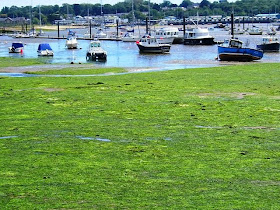Not very happy with today's photos, so will try and get some better ones on my next trip!
When the tide is low the small boats are nestled on the mud flats. There is not much of historic interest here but it's a peaceful and scenic landscape.
Out in the bay you can see St Helens Fort, which was part of a defence system set up by Prime Minister Lord Palmerston in 1859 to defend Portsmouth from the French, though it was never used, leading it to be dubbed a Palmerston Folly.
Each year at low tide, hundreds of people of all ages trek three quarters of a mile across the exposed causeway to reach the Napoleonic fort, which has even been a set for an episode of Doctor Who. The event is never advertised, but the date, usually in August, spreads by word of mouth. Traditionally, walkers climb up and circle the fort's parapet before setting back for shore. There is a window of roughly 30 minutes to make the trip, but most walkers are pretty wet by the time they get back to the beach for the customary barbecue.
 |
| CC Image by Richard Heaven |
At the end of the path we come to St Helens Old Church, which was built on the sands in the 14th century. The church was dedicated to the village's own saint St Helena. The church doubled as a lighthouse when it was painted white in the 18th century to guide ships. Now only the tower remains
Most of this land is owned by the National Trust, and it's a popular spot for a stroll along the sands, through rock pools and coastal woodland and home to many wading birds.
In 1882, the prestigious Royal Isle of Wight Golf Club was founded in the Duver, soon well known as Queen Victoria's sons, including Edward VII, played here. The clubhouse is now a holiday cottage run by the National Trust.
Now in June there are carpets of wildflowers, such as the salt-loving thrift and there are also some rare clovers and autumn squill.





















No comments:
Post a Comment